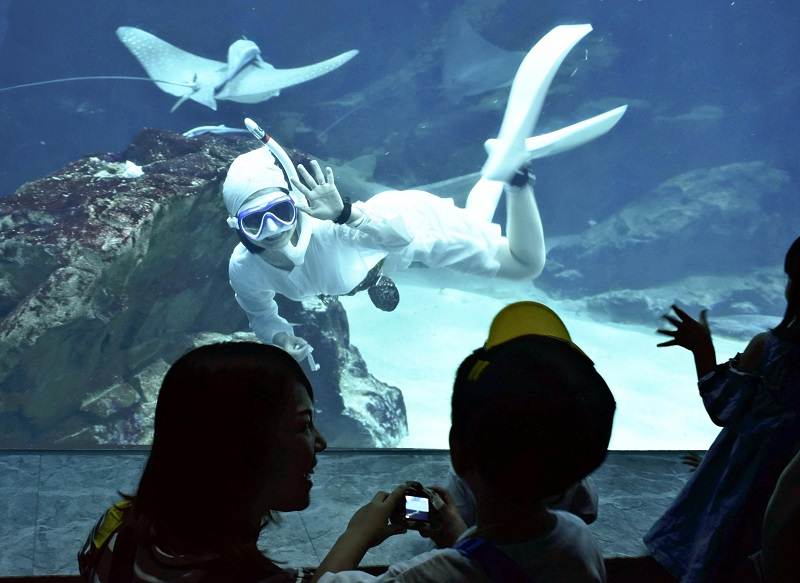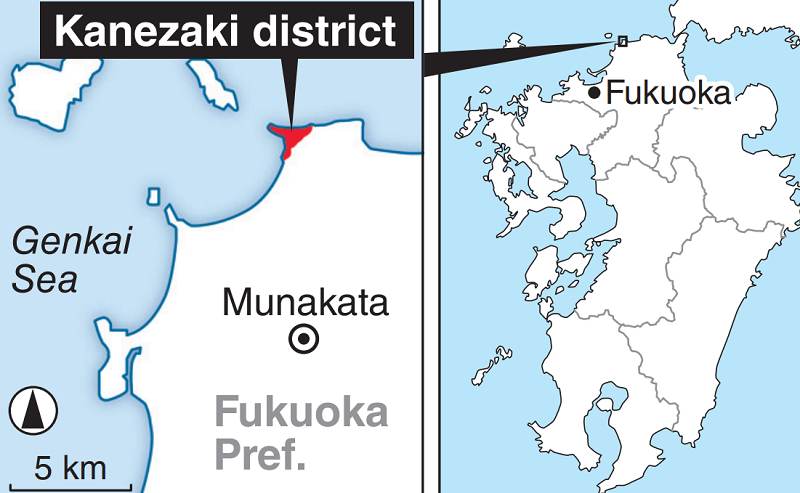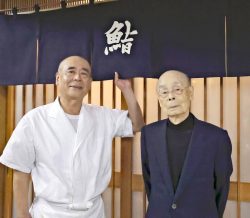
Ai Honda waves to the audience from a tank at an aquarium in Fukuoka in June 2019.
8:39 JST, April 10, 2021

Ai Honda speaks in front of a statue of an ama diver by Kanezaki Fisheries Port.
MUNAKATA, Fukuoka — Two women have decided to become ama divers in Munakata, Fukuoka Prefecture, after working three years as apprentice divers hired by the city government to promote local ama fisheries.
The women are Ai Honda, 33, from Shiga Prefecture, and Yukari Uozumi, 37, from Gifu Prefecture.
The Kanezaki district in Munakata is said to be the “birthplace of ama divers along the Sea of Japan coast.” In the early 1900s, there were about 200 of the women divers in the district, but in 2017, there was only one in her 60s. That year, the city government solicited people all over the country to become ama divers.
The two were hired by the city government on the condition that their term of activity be one year, renewable for up to three years. They moved to the Kanezaki district in the spring of 2018 to begin their training as divers.
Outside of the fishing season, they were responsible for sharing their lives as ama on the internet and promoting local marine products.
For the past three years, the two have been taken to fishing zones to learn diving techniques for various marine species, such as sazae turban shells, abalone, wakame seaweed and sea urchins.
They also demonstrated traditional fishing techniques in a 7-meter-deep tank at the Marine World Uminonakamichi aquarium in Higashi Ward, Fukuoka, to promote Kanezaki’s ama culture.
From 2018 to 2020, the two operated the Amachan Shokudo restaurant in Kanezaki, serving dishes such as kakiage donburi (rice bowl topped with fried fish) using sea eel, a specialty of the district.
Ocean cleaning
The two finished their three-year terms in March, but they both chose to continue on their own as ama divers.
Uozumi will go fishing with her husband, who will operate the boat. Honda will be taken on board by her seniors for the time being, and when her own fishing boat is ready, she will pilot it herself on dives.
“I’m not sure if I’ll be able to make ends meet on my income as a diver,” said Honda, who will no longer receive any salary from the municipality. She will also continue to be geographically separated from her husband Kazuaki, who lives in Yokohama.
However, Honda said, “The people of Kanezaki have treated me so well that it made me want stay here forever.”
Honda also decided to work on collecting marine plastic waste that she had seen in the ocean.
In cooperation with fellow fishermen, she aims to establish a general incorporated association in May to collect plastic waste.
With the help of fishermen who are unable to go fishing on days when the sea is rough, they collect plastic bottles and other waste washed up on the beach and sell them to recycling factories. They return the profits to the fishermen.
Honda has been implementing this system on a trial basis since last year. She hopes to eventually be able to add value to the waste collected in this way as “plastic collected by fishermen to protect the marine environment.”
“If we don’t have a well-balanced ocean, there will be less marine life, and the ama divers’ culture will cease to exist,” said Honda, who was a high school biology teacher before becoming a diver.
“I’d like to take on the challenge of fishing in an environmentally friendly way.”
Birthplace of Sea of Japan’s ama fisheries
The Kanezaki district is located on the Genkai Sea, which is a rich fishing ground where warm and cold currents meet.
Ama divers in the district have had a reputation for being skilled fishers since ancient times. It is said that they traveled along the Sea of Japan coast, including the Noto Peninsula in Ishikawa Prefecture and the Tsunoshima island in Yamaguchi Prefecture, in search of better catches, according to the city government.
It is said some of them settled there and expanded the practices of their fisheries.
In the past, diving to fish was a job reserved for women, as they could maintain their body temperature longer when exposed to cold water. However, with the evolution of wetsuits, men moved in, and women divers retired across the country, including in the Kanezaki district.

A map of Kanazaki district
Related Tags
"Features" POPULAR ARTICLE
-

Sanrio to Open Museum in Yamanashi Pref. Dedicated to Founder, Exhibits Include Hello Kitty, Other Characters
-

Legendary Sushi Chef Jiro Ono Turns 100: ‘I Have No Regrets’
-

Autumn Foliage Surrounds Visitors to Tokyo’s Showa Kinen Park
-

My Daughter No Longer Speaks to Me, But I Want to See Her and My Grandchild
-

Kumamoto: Public Bath Refurbished as Library Where You Can Chat, Take Photos
JN ACCESS RANKING
-

Keidanren Chairman Yoshinobu Tsutsui Visits Kashiwazaki-Kariwa Nuclear Power Plant; Inspects New Emergency Safety System
-

Imports of Rare Earths from China Facing Delays, May Be Caused by Deterioration of Japan-China Relations
-

University of Tokyo Professor Discusses Japanese Economic Security in Interview Ahead of Forum
-

Japan Pulls out of Vietnam Nuclear Project, Complicating Hanoi’s Power Plans
-

Govt Aims to Expand NISA Program Lineup, Abolish Age Restriction
























